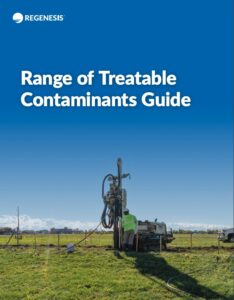Remediation Approaches Overview
for the treatment of contaminated land and groundwater
In Situ Remediation Techniques and Reagents offered by REGENESIS:
Bioremediation – Biological treatment
-
Enhanced aerobic bioremediation – ORC Advanced®
-
Enhanced anaerobic biodegradation – enhanced reductive dechlorination (ERD), enhanced dehalogenation 3DME®, AquiFix™
-
Sorption and enhanced biodegradation – aerobic/anaerobic oxidation and anaerobic reduction PlumeStop® PetroFix®
-
Bioaugmentation (Dehalococcoides Sp.) BDI Plus®
Chemical Treatment – Chemical Oxidation/Reduction/Immobilisation
-
In Situ Chemical Oxidation (ISCO) RegenOx®, PersulfOx®
-
In Situ Chemical Reduction (ISCR) – Colloidal, Sufidated, Zero Valent Iron (ZVI) S-MicroZVI®
-
Metals Immobilisation – 3-D Microemulsion®, S-MicroZVI®
-
In Situ Sorption
-
Colloidal Activated Carbon – Sorption only, or combined with enhanced biological degradation
PlumeStop®, PetroFix®
-
PFAS Specific Treatment
Target the 4 key areas of the PFAS Source-Plume system:
-
Source Treatment, featuring SourceStop® Solid & Liquid (soils, capillary fringe, groundwater)
-
Plume Treatment with PlumeStop®(groundwater, plume)
-
Warranty offering: PlumeShield™
Enhancing Ex Situ Techniques
-
Enhanced Desorption (increased efficiency of physical extraction/pump and treat systems) RegenOx®
-
Soil mixing or spraying ORC Advanced® , RegenOx® , PetroFix®
Integrated Treatment / Combining Remedies
-
The above techniques can be combined or paired with other remedial approaches.
Applicability
Suitable for treating a wide range of contaminants in soil and groundwater, across many different site types and conditions:
- Petroleum hydrocarbons including BTEX, PAH etc, Chlorinated Solvents, TNT, MNT, DNT,
- Pesticides, Herbicides, Metals (including CrVI)
- PFAS and other emerging contaminants
- Brownfield land, legacy sites, redevelopment sites, or other forms of contaminated land
- Remote or restricted access sites
- Commercially active facilities: defense, manufacturing, retail, rail, industrial, pharmaceutical, chemical, logistics
- Source Areas and Plumes
- Remediation to reduce liability or manage risk of contaminant migration

 Americas
Americas Europe
Europe Français
Français Deutsch
Deutsch Italiano
Italiano Español
Español

